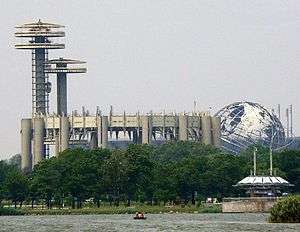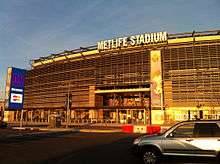Singer Bowl
Coordinates: 40°45′03.4″N 73°50′43.8″W / 40.750944°N 73.845500°W
| Location | Flushing, Queens, New York |
|---|---|
| Opened | 1964 |
| Closed | 1977 |

The Singer Bowl was the former name for a stadium in Flushing Meadows–Corona Park, in the New York City borough of Queens. It was an early example of naming rights in large venues.
History
The stadium was built in 1964 by the Singer Sewing Machine Company.[1] It was donated to be used for the 1964 World's Fair.[1] It later hosted various Olympic trials and concerts over the years, including a 1968 concert headlined by The Doors with The Who as the opening act. Jimi Hendrix also performed there in August 1968. In the summer of 1972, professional boxing was held at the Singer Bowl. Some of the fighters who boxed at the Singer Bowl were former Heavyweight Champion Floyd Patterson and future world champions Vito Antuofermo and Saoul Mamby. Other boxers of note that boxed at the Singer Bowl in 1972 were Edwin Viruet, John Clohessy, Roy Edmonds, Eduardo Santiago and others.[1]
In the early 1970s, the United States Tennis Association was looking for a new place to host the U.S. Open as relations with the West Side Tennis Club in Forest Hills, which had hosted the tournament, were breaking down. The USTA was initially unable to find a sufficient site, but the association's incoming president, W.E. Hester saw the old Singer Bowl from the window of an airplane flying into LaGuardia Airport. The old, long rectangular stadium was renamed the Louis Armstrong Memorial Stadium after a famous Corona resident, jazz trumpeter Louis Armstrong.[1]
The stadium was heavily renovated in 1977 and reopened in 1978 as two venues, Louis Armstrong Stadium, which had significantly more seating than the original stadium, and the adjacent Grandstand. Both are part of the present-day USTA National Tennis Center.[1] When the USTA built Arthur Ashe Stadium next door, the largest tennis-only venue in the world, the seating capacity of Armstrong was reduced to be closer to its original format.
References
Notes
Further reading
External links
 Media related to Singer Bowl at Wikimedia Commons
Media related to Singer Bowl at Wikimedia Commons



